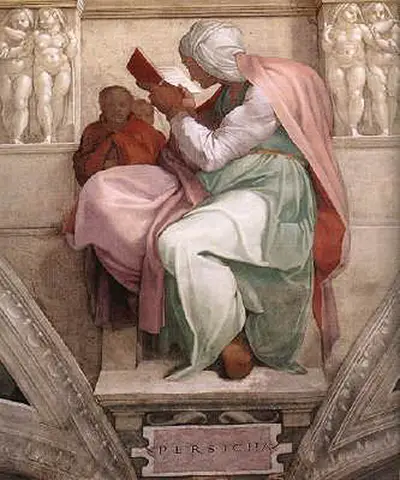This famous figure has been captured by a number of other artists as well, with Guercino capturing Sibilla Persica himself, and a number more following on after the Italian Renaissance. Some passages claim her to be an author who produced some important writings in very early AD. You will notice that within this Michelangelo painting she is seen holding a book which perhaps correlates to this particular tale. She is joined by a number of figures behind her, but is sized in a manner which helps her to truly dominate the composition. Michelangelo uses bright tones of colour for her clothing, perhaps slightly unusually so for this period of art, but the impact was lost after a number of years as wear and tear started to mute these tones. Thankfully, in recent years efforts have been made to restore the paintings to their former glory, and the work has proven successful, whilst also giving an opportunity to check over the condition of each fresco in great detail.
Preservation techniques have slowly improved over recent years, taking in advancements of Science which enables work to be completed in a way that is less damaging to the original paintwork. Similar methods have also been used to better research some works from the Renaissance, but installed pieces such as this will always be limited in what can be done. The Persian Sibyl also features a number of sculptured figures, or at least painted in that style, across the top of the fresco, but these are more of a patterned element which continues into the other neighbouring paintings and was done to produce a synergy between these different pieces. Another common feature of Michelangelo's work here is how they each receive a small plaque painted into the bottom of the painting which confirms the identity of each prophet.
The Sibyls featured here were captured in an alternative style by an artist from the English School in around the early 17th century, whilst some Italian artists who appeared shortly after Michelangelo would also sit and work from his own creations. The English versions were fundamentally different in style and was made using oils, rather than the egg tempera used for fresco paintings. That series can be found in the collection of the Dulwich Picture Gallery in the UK, whose highlights also include the likes of The Nurture of Jupiter by Nicolas Poussin, Girl at a Window by Rembrandt, Elizabeth and Mary Linley by Thomas Gainsborough plus also A View of Walton Bridge by Canaletto. They specialise in art from around the Italian Renaissance up to the 19th century and so cover a range of styles within that.


